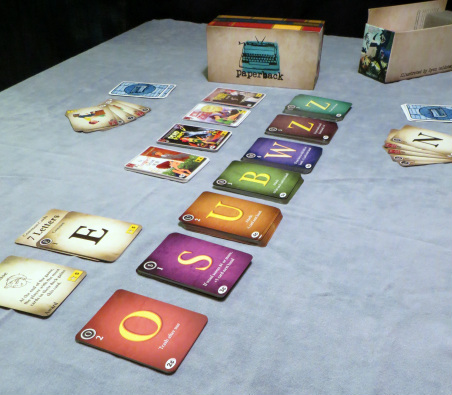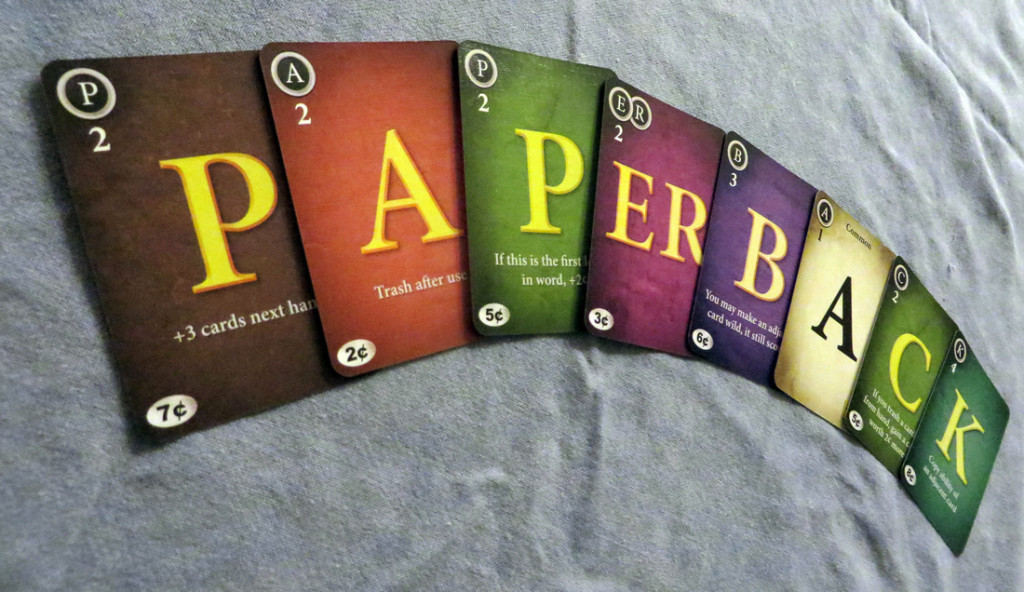I recently praised “Letter Tycoon” for being a word game that utilizes a unique gameplay mechanic: the ability to buy patents on letters. “Paperback”, I found, has a similar unique theme…only here, you’ll be building a deck of letters while spelling out words. Like most deck builders, you’ll start with a very basic deck of cards and will be tasked with choosing what cards you’d like to add to your ever-growing deck. Before we go any further, I’d like to thank Timothy Fowers from Fowers Games for providing me with a free press copy for review purposes.

Paperback: 2-5 Players, Ages 10+, Average Play Time = 45 Minutes
Components
The game includes 17 wood cubes, 11 dividers, 66 letter cards, 8 2 cent vowels, 20 two-letter cards, 11 attack cards, 50 starting deck cards, 28 fame cards (wild), 6 common cards, 5 player powers, 6 theme cards, 4 award cards, and a rule book.
Setup & Gameplay
Each player gets some starting cards for their deck (five 2 cent fame cards, and one T, R, S, L, and N). The four piles for the different ranks of fame cards are set up according to the chart in the manual. The common cards are shuffled, dealing four and splaying them near “the offer”, or grid of cards sorted by price (2 cents, 3 cents, etc.). The 8-10 cent cards are combined into one pile. Each pile is shuffled and placed face up in the above mentioned “offer”. The top card is taken of each pile (except for the 2 cent pile) and placed below it allowing players to purchase either card from each column. Attack cards are only used for the advanced game. To start, everyone draws a hand of five cards from their deck, the first player being the one to most recently have finished reading a novel.
On a player’s turn, they’ll:
1. Create a word. They’ll be able to use the cards in their hand by laying them out in front of them. They can also refer to the topmost common card, leaving it on the length track. No proper nouns, names, or places are allowed.
2. Check the word length. If the word (number of letters) is equal to or longer than the highest number shown on the length track, then they can take the common card (revealing the next common card for everyone to use and possibly gain. When the last common card is gained, the game is over.
3. Resolve any abilities. If any of the cards used to form the word have special abilities, they’ll activate.
4. Score the word. The player adds their score (each letter has a score on the top left of the card), including the common card (if used/referred to).
5. Buy cards. Using the score totaled from step four, they’ll be able to purchase any number of cards so as long as the have the points to do so. Purchasing an alternate card (the single card below the pile’s column) requires that you replace it from the pile above. The cost of each card is listed in the lower left of the card. Unspent money/points is lost at the end of the turn.
6. Discard cards. All cards in their hand, including any purchased, go into their discard pile.
7. Draw next hand. The player draws five cards, plus any additional cards granted by abilities in the previous turn. If their deck runs out of cards, then they’ll shuffle their discard pile and keep drawing.
The game ends when any of the two fame piles are empty or when there are no more common cards. Each player adds up the fame points on the cards they have in their hands, decks, and discard piles and the person with the most fame, wins the game.
Editor’s Note: The above doesn’t cover all of the rules found in the manual, but should give you an idea as to how the game is played.

The Review
“Paperback” combines the ideas of spelling words for points and deck building rather nicely. The instructions had me scratching my head a bit, especially with regard to game setup. After all, you have a huge grid of cards (called “the offer”), common cards, and fame cards…all of which are arranged in a particular way. Unless you know how these cards operate, it can be confusing to understand why they are being set up the way they are. After a game or two however, you’ll quickly get a feel for what’s going on. The deck building aspect works very well and stays true to the genre. For example, you’ll be able to trash cards in your hand (using abilities) that let you buy more expensive cards than you’d otherwise not be able to afford.
In addition, the game includes a number of different optional cards that can spice up play. Attack cards, for example, encourage direct conflict while player powers, on the other hand, give each player a unique ability to use. An award card can be included and awarded at the end of the game, based on whether or not the listed condition was met. There’s a spacebar card that, as a common card, lets you create two words from your hand instead of one and gain a point to boot. Theme cards force players to make words that fit the listed theme and again, these are all optional ways to play. Cubes come included and while optional, can be used for a number of different things. They can be used as rewards for helping other players or to say, discard your hand. All of these things add a lot of variety to the game allowing it to appeal to casual and hardcore spellers alike.
“Paperback” is going for $24.99 via the official site (link below). Normally I consider $10-$20 to be average for a card game, but there’s a lot of quality content here to warrant the extra dough. Give this one a look!
Final Verdict: 9/10
—
Purchase: https://fowers-games.myshopify.com/collections/frontpage/products/paperback
—
